

A Lady in London
And Traveling the World
Lady’s Bloomsbury Walk and Map
Today I want to share A Lady in London’s free self-guided Bloomsbury walk and map with you. This part of central London is packed with everything from literary highlights to leafy squares and famous museums. Everyone from Virginia Woolf to Charles Dickens has called this London neighborhood home, and it’s a great place to explore. My walking route will help you discover the best of Bloomsbury on foot. I hope you enjoy the journey.

Bloomsbury Walk
From Russell Square to the British Museum, Bedford Square to Lamb’s Conduit Street, Bloomsbury is one of the most famous central London neighborhoods .
Set in a beautiful part of the UK capital, my Bloomsbury walk is the perfect way to get into London’s literary past, explore pretty streets, eat and drink at independent cafes and restaurants, and indulge your inner culture lover.
You can see more walks in the book London’s Hidden Walks , too. It’s for you if you enjoy discovering the UK capital’s off-the-beaten-path areas. You can get it here .
I’ve also written a whole post about London walks books , so you can take a look at it if you want more options.

Bloomsbury Walk Route
My self-guided Bloomsbury walking tour starts at Russell Square station. It’s centrally located and has great transport links, so you can arrive by tube, bus, bike, or on foot from other parts of the city.

When you exit the Underground station, take a left on Bernard Street, then another quick left on Herbrand Street. It will take you past a historic pub in atmospheric surroundings. When you reach Guildford Street, turn right to get to Russell Square.

When you get there, take a right to walk up to the intersection at the northeast corner of the square. As you go, you’ll start to get a glimpse of the Georgian townhouses and pretty green space the area is known for.
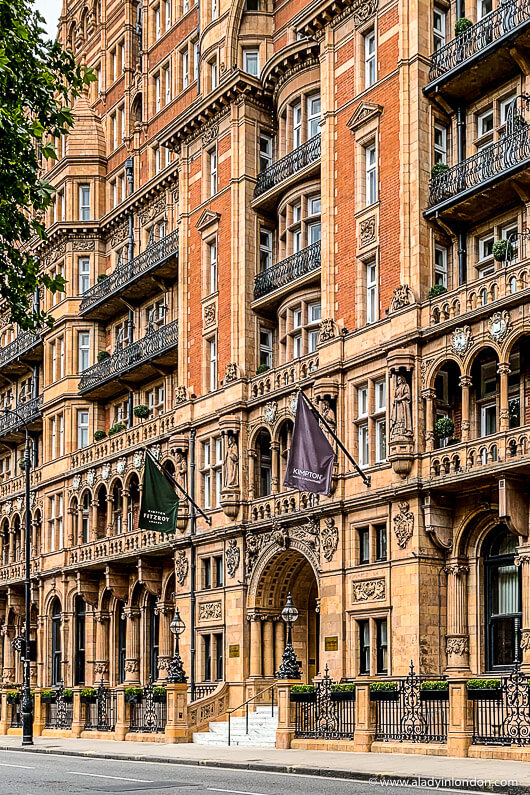
Cross the street to enter Russell Square, then walk diagonally through it to get to the southwest corner. Once there, take a right on Russell Square and a quick left on Montague Place.
Walk down Montague Place, passing by the back of the British Museum and the south side of Malet Street Gardens as you make your way to Bedford Square.

When you arrive at Bedford Square, walk around it and take in the stunning Georgian buildings and doors as you go. This is one of my favorite places to take in Bloomsbury’s heritage architecture.
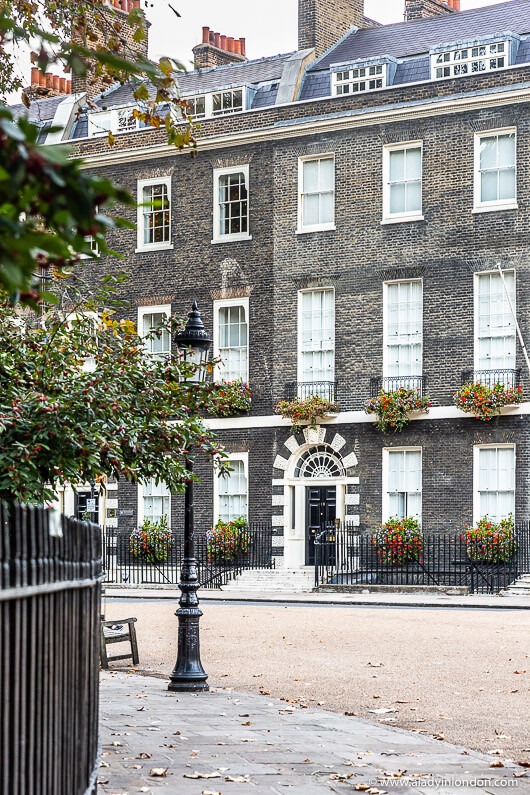
Once you’ve explored the square, exit by taking a right on Bloomsbury Street and then a left on Great Russell Street. This will bring you past the front of the British Museum.
You can go inside and have a look around if you want to, or continue your Bloomsbury walk by turning right on Bury Place.

There are lots of shops on Bury Place, including the London Review Bookshop (you might remember it from my London literary walk or my itinerary for London for book lovers ).
You can pop in for a browse or have a treat at the adjacent cake shop (yum…cake and books).

From Bury Place, take a left on Bloomsbury Way and walk down to Bloomsbury Square. Dating back to 1665, this is London’s oldest square. Stroll around it and keep an eye out for the historic details on the buildings as you go.
From the square, continue your Bloomsbury walk by exiting from the northeast corner via Bloomsbury Place. When you get to the end, take a left on Southampton Row and follow it until you reach Cosmo Place.
Turn right to walk down Cosmo Place. This pedestrianized street will take you to Queen Square. The public garden in the middle is a good place to rest your feet if you need a break.
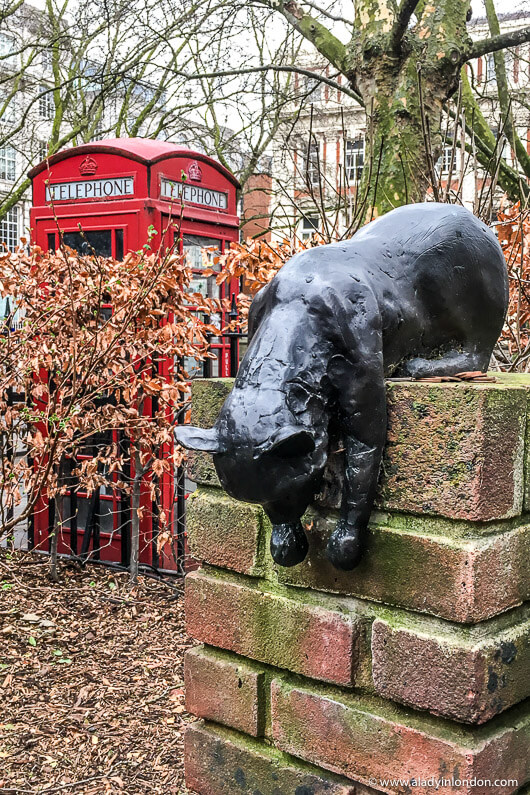
There are statues and sculptures all around, including one of a cat. There’s also an 18th-century pub on the corner of Cosmo Place that has historic connections to King George III and his wife, Queen Caroline.
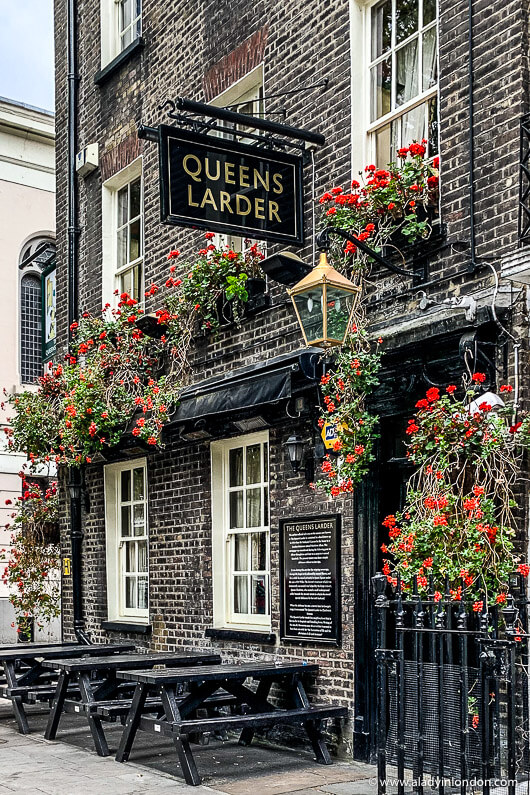
Once you’ve walked around the garden, exit from the northeast corner via Queen Anne’s Walk. When you reach the end, turn right on Guildford Street and continue your Bloomsbury walk until you get to Guildford Place.
Turn right on Guildford Place and follow it as it becomes Lamb’s Conduit Street. There are lots of great restaurants, shops, and cafes here, so it’s worth spending some time exploring.

When you reach Theobald’s Road, turn left and walk east until you get to John Street. Take a left on John Street, passing historic facades and corner pubs as you make your way north and the road becomes Doughty Street.
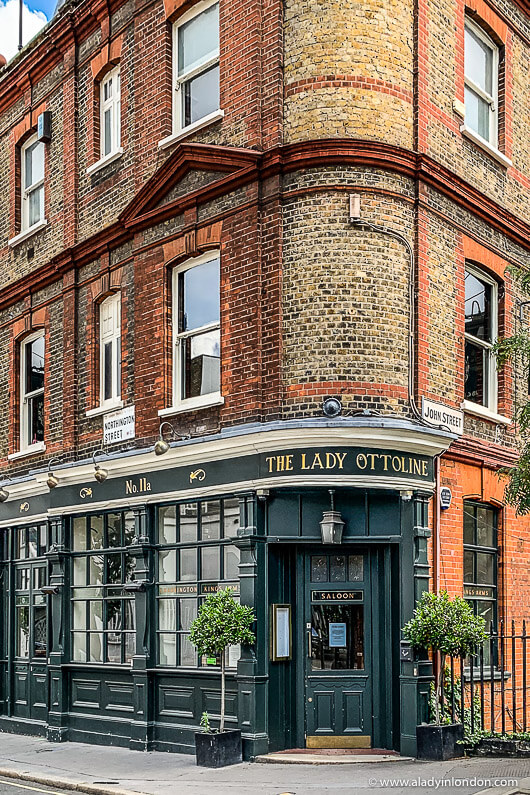
When it does, you’ll pass the Charles Dickens Museum. You can pop in to see his former home if you want to.
If not, continue your Bloomsbury walk by following Doughty Street north as it becomes Mecklenburgh Square, then Mecklenburgh Street. When it ends at Heathcote Street, turn left and follow the street to the end.
On your right you’ll see a gate that leads into St. George’s Gardens. This secret garden is set in a former 18th-century graveyard. It’s a great place to rest your legs in peaceful surroundings.

Once rested, exit St. George’s Gardens at the northwest corner and walk west down Handel Street until you reach the Marchmont Community Garden, a pretty little urban green space.

Walk through the garden to get to Marchmont Street, where you’ll turn right to take in more of Bloomsbury’s restaurants and cafes.
When you’re done, continue your Bloomsbury walk by turning left on Tavistock Place. It will lead you to Tavistock Square Gardens.
This green space features statues of everyone from Mahatma Ghandi to Virginia Woolf. The latter was a member of the Bloomsbury Group and lived at 52 Tavistock Square between 1924 and 1939.

The square is also lined with important buildings, including the headquarters of the British Medical Association. It was designed by prominent English architect Edwin Lutyens in 1911.
When you’re done exploring, exit Tavistock Square at the southwest corner and follow the street called Gordon Square until you reach Gordon Square and Woburn Square. They’re right across from one another.
You can walk through and around them if you want to, or continue your Bloomsbury walk on Byng Place. Don’t miss the many university buildings and the row of red phone boxes by Euston Church as you go.
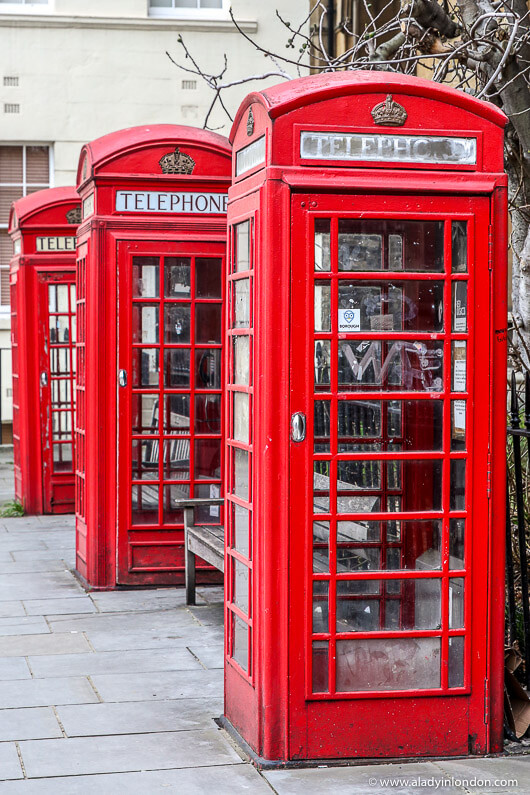
After Byng Place becomes Torrington Place, turn left on Gower Street and follow the colorful doors and brick buildings down to Store Street.
Turn right on Store Street, where you’ll find lots of restaurants, shops, and cafes (including one of the best coffee shops in London ).
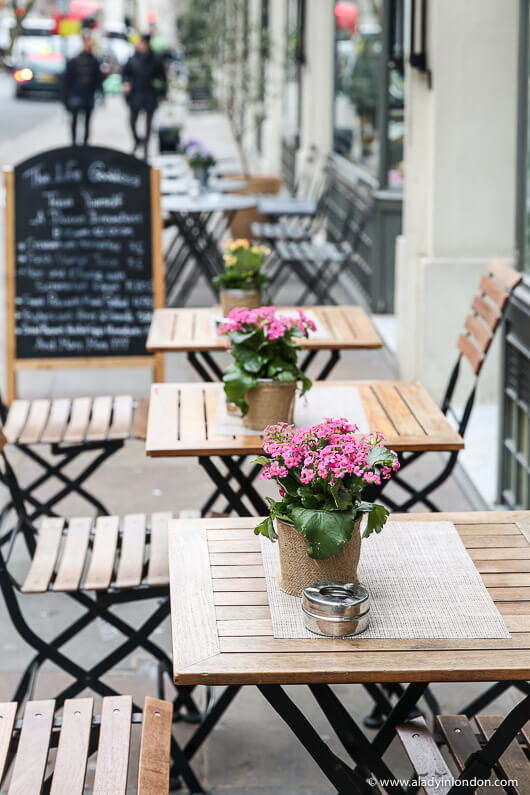
When Store Street meets Tottenham Court Road, turn right and walk up to the Goodge Street tube station. Your self-guided Bloomsbury walking tour ends here.
Walk Details and Map
Map of the first half of the walk: https://goo.gl/maps/moAKhwXN7KVtg8dS7
Map of the second half of the walk: https://goo.gl/maps/PcyNCTcJvFAGJhGz9
Further afield: Fitzrovia , Clerkenwell , King’s Cross , Regent’s Park , Soho , Covent Garden

Bloomsbury Walking Tour
I hope reading through my Bloomsbury walk has made you excited to see this part of central London. It’s a great place to get into the heart of the city.
If you’re interested in doing more walks in the area, head over to my blog post about central London walks . You can see more self-guided London walking tours and maps on my post with all the ones I’ve created, too. Happy walking!
Find this post helpful? Buy me a coffee!
New here? Join thousands of others and subscribe to the A Lady in London blog via email .
One of the links in this blog post is an affiliate link. At no cost to you, I earn a small commission when you click on it and make a purchase. It doesn’t affect the way you shop, and it’s a great way to support the A Lady in London blog.
8 Comments on Lady’s Bloomsbury Walk and Map
It looks so nice! I absolutely loved the bicycle :)))
Absolutely love the description of your walks….feel I am there with you….but I will certainly get out there and do myself.
Thank you so much! I’m glad you feel you’re on the walks with me. I hope you enjoy this one when you do it.
Just done this lovely walk, stopping and start along the way. Breakfast in Russell Square garden, Browsed in London Review bookstore, lunch in Landry Oteline. All really lovely. A busy wedding weekend ahead and this was a perfect quieter way to spend today, wandering around this lovely area of London. Thanks.
You’re welcome! I’m so glad you enjoyed it.
I just did this walk today, as I am staying in this area for work this week. Such a nice stroll – thank you!
Leave a Reply Cancel reply
Your email address will not be published. Required fields are marked *
This site uses Akismet to reduce spam. Learn how your comment data is processed .
© Copyright A Lady in London 2007 - 2024. Privacy Policy.

Private Guided Walking Tour of Bloomsbury, London
- Red Lion Square Gardens
- Lambs Conduit Street, Camden, London
- Great Ormond Street
- Coram's Fields
- The Brunswick Centre
- Tavistock Square
- Russell Square
- The British Museum
How to get there?
Select date and session.
No booking fees
Similar experiences
Secret london walking tour, hidden london walking tour, paddington walking tour, secret old london walking tour, private guided tour of london's east end, private tour: personal travel photographer tour in london, food and drink walking tours in west london's notting hill area, london: notting hill self-guided walking tour with an app, unlimited london walking tour: 3-day access, mary poppins walking tour of london, discover our top experiences, moco museum london, horizon of khufu: an immersive vr expedition to ancient egypt, pulse: beyond delight, serial killer: the exhibition - london, paradox museum london, the formula 1® exhibition, jeff wayne's the war of the worlds: the immersive experience, the gunpowder plot experience, the murdér express: an immersive dining experience, bbc planet earth iii live in concert - london, the art of the brick: an exhibition of lego® art, van gogh: the immersive experience, bubble planet: an immersive experience, life chronicles: an immersive vr journey through the earth's history, batman unmasked - london, related categories.

Sorry, JavaScript must be enabled to use this web app

Inspiring City
UK based art blog with the best street art and artist interviews
Free Walking Tour around Bloomsbury and Holborn

The area around Holborn and Bloomsbury is a great place to walk around and explore. Personally we’ve got to know pretty well over the past year or so. Packed full of history. It’s also the location of the popular Sunday Assembly which bases itself out of the Conway Hall every second Sunday. It’s fun and something we’ve enjoyed going to for the past couple of years. As a result we wanted to get to know the area a little bit more.
Bloomsbury essentially sprawls from Holborn up towards Euston Road and so that’s where this walk will be heading. The area’s name dates from Norman times when William De Blemond acquired the land. The suffix ‘bury’ denotes an area of land or manor that belongs to a person. Bloomsbury therefore is simply William De Blemond’s manor. Back in the day of course there would have not been much to see other than marshy fields. But the name has stuck.
The name Holborn meanwhile is thought to derive from the old English words ‘hol’ meaning hollow and ‘bourne’ meaning brook. Given the area’s proximity to the old River Fleet. This could be a reference to the once fairly substantial river just to the east. Or it could be a reference to another tributary called the ‘old brook’. The historian John Stow speculated that this could have run into the Fleet at Holborn bridge. London was once a city of many rivers. It’s just that most of them have been lost to development over the years.
Walking Tour of Holborn and Bloomsbury
So, for this walk we’ll start from Holborn tube station. Walk up towards Russell Square and then finish at Euston Road tube station. We’ll stop at some cool historic places of interest along the way.
Start – Holborn Underground Station to Red Lion Square via Red Lion Street
From the exit at Holborn immediately cross the main road known as High Holborn. Then keep heading down towards the direction of Chancery Lane until you meet the junction with Red Lion Street . There on the corner is the Old Red Lion Pub which now dates from 1899. However this was originally established much earlier in the 16th century. Then it was known as the Red Lyon Inn and it has a unique place in history.

The hanging of Oliver Cromwell
Following the execution of Charles I on 30 January 1649. The ‘Commonwealth of England’ (1649-1653) was established. This was dominated by Oliver Cromwell. In 1653 Cromwell then took full control and established the Protectorate . He would then serve as ‘Lord Protector of England, Scotland and Ireland’. Following his death in 1658 he was succeeded in the post by his son Richard. That however was only until 1659 when he was ousted by parliamentary troops. In 1660 Parliament then offered to restore the monarchy to Charles II.
After Charles II returned to the throne, parliament passed the Indemnity and Oblivion Act 1660. This act basically restricted any reprisals against anyone who had committed crimes during the Civil War to those who had been involved in the death of Charles I. For those involved in his trial. Indeed those had signed his death warrant. It meant that they now would go on trial themselves . Many were found guilty and hung, drawn and quartered.
Exhumation of the Lord Protector
As a result the exhumation of the bodies of Cromwell and two other men who had signed his fathers death warrant were ordered. They were Cromwell’s son in law, Henry Ireton (1611-1651) and the judge John Bradshaw (1602-1659). All were to be taken to Tyburn and then posthumously executed as traitors. The plan was to gibbet and behead the corpses before throwing them into a pit,

On the way to the gallows the bodies were stored overnight in the Red Lyon Inn’s yard. It is rumored that during the night of their internment, the bodies were swapped . Then re-buried in a pit in the fields which used to surround the pub. It’s impossible to know for sure of course but it’s possible that that pit was in the area of today’s Red Lion Square. Giving rise to many a story of the ghosts of the men haunting the area to this day.
The Battle of Red Lion Square
Head up Red Lion Street until you come to Princeton Street where you should turn left. The square is immediately ahead. It gained notoriety when on 10 June 1684 a pitched battle broke out. This was between workmen developing the site and around 100 lawyer’s from the nearby Gray’s Inn. The lawyer’s had protested at the development. They claimed that if the fields were developed they would lose their ‘wholesome air’ and be detrimental to their health. The lawyer’s turned up armed with bricks and whatever else they could get their hands on. However they were fought off by the workmen who won. It cleared the way for the site to eventually be developed.
Red Lion Square is also the site of the Conway Hall which occupies the north-eastern corner. Opened in 1929 it is owned by the Conway Hall Ethical Society. It was established as a centre for free thought and debate. It was named after Moncure Daniel Conway the American anti-slavery campaigner. He was a man who, whilst in London, was a staunch supporter of women’s suffrage. It now also hosts the famous Sunday Assembly .

Red Lion Square to Great Ormond Street
From Conway Hall on the square walk up the little passage heading east next to the hall. There you’ll rejoin Red Lion Street . Turn left and then cross over the main road and continue along Lamb’s Conduit Street . Named after the philanthropist William Lambe, who in 1564 gave £1500 to support the rebuilding of the Holborn Conduit . This was an Elizabethan dam made in a tributary leading to the River Fleet. The intention being to bring fresh water into London. The remains of the conduit pump can still be seen. This is on the corner of Lamb’s Conduit Street and Long Yard at the top end of the street. The exact route of the conduit is however now long gone and unknown.
Rugby Estate
The street is a lovely little find. It is full of independent retailers and the ‘little bird’ website features a number of them here . Keep walking up the street to the turning with Rugby Street . The name remembers the establishment of the Rugby estate by the grocer Lawrence Sherrif. He had sold spices to Elizabeth I in the days before she became queen. Rewarded by her with his own coat of arms in 1558. He eventually bought an undeveloped plot of land known as Conduit Close. Developing it prior to his death in 1567. He then left the land as an endowment to help build a school and almshouse in his home town of Rugby. This effectively established the Rugby estate of today.

Great Ormond Street to Russell Square Tube Station
Carry on up Lamb’s Conduit to the junction with Great Ormond Street and there turn left. The street gives its name to the famous children’s hospital. This can now be seen on the right hand side of the street. It’s also mid way through our walking tour through Holborn and Bloomsbury. Originally opened in 1852 by Charles West. It was the ‘Hospital for Sick Children’. Charles Dickens was a big supporter writing “Our children perish out of our homes, not because there is in them an inherent dangerous sickness… but because there is, in respect of their tender lives, a want of sanitary discipline and a want of medical know.ledge.”
The Madness of George III
Carry on down Great Ormond Street towards Queen’s Square . The area was named after Queen Anne and laid out in 1716. However it actually contains a statue of Queen Charlotte the wife of King George III. He had been treated at a house in the square between 1788 and 1789 by his physician Francis Willis who lived there. Sadly I can’t seem to identify exactly which one the house was. The ‘ Queen’s Larder ‘ pub is named after Queen Charlotte as she had rented a small cellar beneath the building. There she would cook and make ‘special foods’ for her husband as he received his treatment.
The cause of George III’s illness has been much debated. He had experienced a number of bouts of mania with one leading suggestion being that he had bipolar. The episode for which he was treated by Francis Willis was so serious that it led to a Regency Bill passed by parliament. His recovery was so dramatic though that the bill was pulled before it could pass the House of Lords. The apparent success in alleviating George III’s illness was seen as a major step in the recognition of the developing specialty of psychiatry

Medical Associations
The area does of course have a long association with medicine. In addition to ‘Great Ormond Street Hospital’. The square also adjoins the ‘National Hospital for Neurology and Neurosurgery’. Also the ‘Royal London Hospital for Integrated Medicine’. Itself formerly known as the ‘London Homeopathic Hospital’.
Exit the square via the northern end of the square via the alley known as ‘ Queen Anne’s Walk ‘. Turn left on Guilford Street and then take a right after a few minutes on Herbrand Street . Walk up there until you reach Bernard Street . Turn right and there is the Russell Square tube station .

Russell Square Tube to the Foundling Museum
Russell Square itself is named after the family name of the Dukes of Bedford. In particular the 5th Duke, Francis Russell . He owned the land and was responsible for developing much of the area in the 17th and 18th centuries. Russell commissioned the developer James Burton to make the area available for residential use. Burton has his stamp on much of the properties around Bloomsbury to this day as a result.
Roger Fry and Post Impressionism
Across the road from the tube station look out for the Pret a Manger on the corner. There is a plaque to Roger Fry (1866 – 1934). A painter and art critic he was a leading member of the Bloomsbury Group . Fry, used to live in a property on the site and was a scholar of the old masters. He became an advocate of the developments in French painting. He coined the term ‘post-impressionism’ and was seen as the first figure to raise awareness of modern art in Britain. According to the Tate. “The taste Fry influenced was primarily that of the Anglophone world, and his success lay largely in alerting an educated public to a compelling version of recent artistic developments of the Parisian avant-garde.”

Marchmont Street
Continuing our walking tour of Holborn and Bloomsbury. Carry on down Bernard Street and take the first left onto Marchmont Street . To the immediate right is the grade 2 listed Brunswick Centre. It was designed by Patrick Hodgkinson and completed in 1972. Originally meant to be a holistic community incorporating housing, shopping and general amenities in a single development. It fell into disrepair before being renovated in 2000 . Now it stands as a vibrant place to shop and eat.
Carry on up Marchmont Street and you’ll see a number of blue plaques which the residents themselves have arranged. This followed a project with the Marchmont Association to reconnect with the history of the street. Famous residents who you will come across include the comedian Kenneth Williams at number 57. Mary Shelley the author of Frankenstein at number 87. Richard Greene the actor who starred in the ‘Adventures of Robin Hood’ lived at number 65. There are also plaques to less well known residents of the street. Take your time and have a look as you wander up.

Tokens on Marchmont Street
Another cute little quirk about Marchmont Street are the little tokens embedded in the pavement as you walk up. These tokens are replicas of ones found in the Foundling Hospital which was nearby. They are now remembered with the Foundling Museum a short walk away. The tokens would have been left with abandoned children. When, in 1741, the Hospital first opened its doors. Mothers were asked to ‘affix on each child some particular writing, or other distinguishing mark or token . This was so that the children ‘may be known thereafter if necessary’.
Thomas Coram and the Foundlings
At the top end of the Brunswick Centre take a right into the Marchmont Community Garden. Then enter Handel Street .The street remembers one of the foundling hospitals earliest supporters the composer George Frideric Handel . A concert arranged by Handel in 1749 raised money for the hospital and the year after he became a governor. Carry on straight down until you reach Henrietta Mews . There at the end is the Foundling Museum where the Hospital is now remembered. The term ‘ foundling ‘ is historic. It would have been applied to babies which had been abandoned by their parents and cared for by others.

To the south of the museum is Coram’s Fields , so named after the benefactor Thomas Coram . This was the original location of the hospital itself. It was established by Coram in 1739 when the site had formerly been known as ‘Lamb’s Conduit Fields’. Coram had been frequently shocked by the sight of infants exposed in the streets. Often in a dying state. He began to agitate for the foundation of a foundling hospital. A place where children and orphans who could not be properly cared for could be looked after. The resulting hospital was the result of years of campaigning and in 1741 the first babies were admitted. Another little quirk of Coram’s Fields is that even now, access is only permissible by adults, if they are accompanied by a child.
The Foundling Hospital to Gordon Square Gardens
From the museum retrace your steps back to Handel Street . Then take the junction with Hunter Street and then turn left down Tavistock Place . Walking straight down until you come to Tavistock Square. The square was developed by James Burton in 1820’s as part of the development of the Bedford estate. Thomas Cubitt was also responsible for the build of a number of the houses around the square.

Tavistock Square
Turn right on the road also known as Tavistock Square . Then walk up towards the middle of the square where there will be an entrance. At the opposite side of the road is a memorial to the victims of the 2005 London Bombings . This was where a bomb was detonated on a London bus. It killed 12 innocent people as part of a wider co-ordinated terrorist attack in London on 7 July 2005.
Opposite the memorial, in Tavistock Square itself there are a number of statues and monuments. There are statues to Mahatma Ghandi. He supposedly studied at the nearby UCL although the evidence as to whether he did any studying is unclear. The square also contains a bust of Virginia Woolf. The famous author and member of the Bloomsbury Group once lived nearby. Louisa Aldrich Blake , the first British woman to obtain the degree of ‘master of surgery’ is also remembered. She played an important role in surgical efforts during the First World War. Other notable memorials in the square include ones to the victims of the atomic bombings of Hiroshima and Nagasaki. There is also a stone which commemorates conscientious objectors from all over the world.

Where Dickens once lived
Head towards the north eastern end of the square. Then look towards BMA House the headquarters of the British Medical Association since 1925. It was designed by Edwin Lutyens in 1911. The site was formerly one of the homes of Charles Dickens . He lived there from 1851 to 1860 though now extensively redeveloped. Here Dickens wrote ‘Bleak House’, ‘Little Dorrit’ and ‘A Tale of Two Cities’.
Gordon Square
Head west along the top of Tavistock Square towards Endsleigh Place and then take a left down Gordon Square . The square was another to be developed by Thomas Cubitt in the 1820’s. A number of the buildings were also once the homes of a number of different members of the Bloomsbury Group . The house at number 46 in particular is notable. This was where the first evenings of discussion were held. The home was lived in between 1904 and 1907 by the siblings Thoby, Adrian, Virginia and Vanessa Stephens. The latter two now being better known as Virginia Woolf and Vanessa Bell. A number of the buildings are now owned by the nearby University College London (UCL).

Gordon Square to Euston Road
At the bottom of the square turn right towards the impressive Grade I listed Church of Christ the King. Built by John Raphael Brandon between 1851 and 1854. Head straight on along Byng Place . Head past an entrance to the UCL where if you’ve got time you could take a detour to see the famous Petrie Museum of Egyptian Archaeology. This is a university museum which is free to the public. Its also packed full of one of the most amazing collections of Egyptian and Sudanese archaeology in the world. Established by Flinders Petrie . He was one of the foremost egyptologists of his generation. In 1892 he was made aprofessor of Egyptology at UCL. He had made a whole raft of discoveries during his excavations much of which are now in the museum.
Grant Museum of Zoolology
Soon our walking tour from Holborn to Bloomsbury will conclude. Walk to the end of the road to the junction with Gower Street , turn right and walk up. There is another museum on the left hand side of the junction with University Street which is also worthy of note and also free. There, the Grant museum of Zoology can be found. Established in 1828 as a teaching collection of zoological specimens by Robert Grant. On his death he left the collection to the university. These resulted in one of the most unique and slightly disturbing collections around.

Walking from Holborn to Bloomsbury
Further up Gower Street to the right is the entrance to the UCL itself. Hidden away from the road it is the impressive main entrance to the university itself. Known as the Wilkins building it was designed by William Wilkins , the architect also responsible for the National Gallery. Work began in 1827 and then ended in 1829. That was when the funds ran out with only the portico and dome finished. The building was eventually finished in 1985 a full 158 years after the first stone was laid.
Keep going straight up Gower Street and you’ll come to Euston Road . The Euston Road and Warren Street stations nearby.
The walk around Bloomsbury and Holborn was researched during October 2017 and updated in December 2019. It was inspired by a free walk provided as part of the Bloomsbury Festival . Many thanks also to Isabel Cameron who provided a number of additional spots and tips about the area.
For more related posts from Inspiring City check out these:
- A Free Historic Walking Tour around Old Street and Moorgate in London
- A Curious Route Walking Tour around Whitecross Street and the Barbican
- Free Walking Tour of the East End of London
- Bloomsbury Locations in Sussex
Share the love
- Click to share on Twitter (Opens in new window)
- Click to share on Facebook (Opens in new window)
- Click to share on WhatsApp (Opens in new window)
- Click to share on Reddit (Opens in new window)
- Click to print (Opens in new window)
- Click to share on Pocket (Opens in new window)
- Click to share on LinkedIn (Opens in new window)
- Click to share on Pinterest (Opens in new window)
- Click to email a link to a friend (Opens in new window)
Related Posts
Discover more from inspiring city.
Subscribe to get the latest posts sent to your email.
Type your email…
Published by inspiringcity
View all posts by inspiringcity
That was an impressive armchair walk/read!…. Well worth stepping out to do indeed..
Thanks Mitch, it’s a fascinating area with some great artistic links particularly with the Bloomsbury Group. Am hoping to do a follow up but we’ll see how much time I get 😉
Look forward to the follow up Stuart… Cheers!!
- Pingback: Famous London locations of the writers and artists of the Bloomsbury Group | Inspiring City
- Pingback: Tribute Mural to the Famous Hungarian Novel 'The Paul Street Boys' appears in Bloomsbury - Inspiring City
Leave a Reply Cancel reply
Subscribe now to keep reading and get access to the full archive.
Continue reading
- United Kingdom
- A Walking Tour Of Bloomsburys...
A Walking Tour of Bloomsbury’s Architectural Landmarks

Bloomsbury, a once aristocratic enclave and London’s first suburb, is a network of quiet squares and grand Georgian terraces. The area has long attracted artists, authors and lawyers who weaved the area’s ambience into their work.


Gray’s Inn Gardens
Red lion square.
Park, Building

Bloomsbury Square

British Museum
Building, Museum, Library

Become a Culture Tripper!
Sign up to our newsletter to save up to $1,200 on our unique trips..
See privacy policy .
Russell Square

Tavistock Hotel

Fitzroy House

7 Things to Do For a Fun Day in Camden Town

30 Quirky and Unusual Things to Do in London

The Top 10 London Restaurants With a View

The Top Things to Do in Notting Hill

13 Top Shoreditch Restaurants You Should Try

Top 10 Things To See And Do In Paddington, London

The 8 Best Things to See and Do in Surrey, UK

The Best Bars to Visit in Soho, London

The Top Things to Do in King’s Cross, London

The 10 Best Things to See and Do in Chelsea, London

The Best Things to Do and See in Soho, London

The 12 Best Hotels in Shoreditch, London
Culture Trip Summer Sale
Save up to $1,200 on our unique small-group trips! Limited spots.

- Post ID: 1063235
- Sponsored? No
- View Payload
Attractions
- Writers Walk

About this Walk
Wander through the Bloomsbury area of London, made famous by Virginia Woolf and Charles Dickens, on this writers walk and see tourist attractions such as the British Museum, the Lamb pub, Great Ormond Street Hospital and other places associated with famous British writers.
Allow 2 hours.
Best time to do it is any time during daylight hours, preferably in dry weather as there isn’t a lot of shelter on this walk. Written in 2003 and updated in 2014.

General Route
Start at Tottenham Court Road station – Bedford Square – Senate House – Gordon Square – Tavistock Square – Russell Square – Brunswick Square – Great Ormond Street Hospital – Corams Fields – Lamb’s Conduit Street – Theobalds Road – Bloomsbury Square – Museum Street – British Museum – end at Tottenham Court Road station
click to view map in full screen

Senate House
Tavistock Square
British Museum
Coram’s Fields
Buy this walk in a handy booklet
The walk starts and ends at Tottenham Court Road station. From Tottenham Court Road station, take exit 2, cross the lights opposite the Dominion Theatre and turn left. Then turn right down Bayley Street, which brings you into Bedford Square
The Pre-Raphaelite Brotherhood and Bedford Square
The Pre-Raphaelite Brotherhood, a group of “artistic rebels”, was founded in 1848 at no. 7 Gower street, just around the corner from Bedford Square. Its central figure was the painter and poet Dante Gabriel Rossetti and its other members included 19th century English painters, poets, and critics who, as a group, reacted against Victorian materialism.
Essentially Christian in outlook, the brotherhood deplored the imitative historical and genre painting of their day. Together they sought to revitalise art through a simpler, more positive vision. In portrait painting, for example, the group rejected the somber colors and formal structure preferred by the Royal Academy.
Did You Know?
Bedford Square is the only complete Georgian square left in Bloomsbury. Circular in shape, it was built between 1775 – 1780 and though originally residential, it is now occupied by a number of publishing houses including Jonathan Cape, Hodder and Stoughton and Michael Joseph.
continue directly ahead (the road becomes Bedford Square), stopping at the corner of Gower Street and Montague Place
Charles Darwin, Millicent Garrett Fawcett and Gower Street
Charles Darwin lived in Gower St between 1838 and 1842, where he wrote part of The Origin of Species.
Another famous resident was Millicent Garrett Fawcett, who lived at number 2 Gower Street. This famous suffragette led the constitutional wing of the suffragist movement from the late 1800’s until victory in 1928 (when women were finally given the vote).
Gower Street is also home to University College London and the Royal Academy of Dramatic Art.
turn left along Gower street then turn right at Keppel street
George Orwell and University of London Senate House
This building was the inspiration for George Orwell’s Ministry of Truth in his famous novel, 1984.
At the time he wrote the book (in 1949), the building was the tallest in London (it is 210 feet high). Built in 1932, during world war two the building was used as the Ministry of Information.
In John Wyndham’s The Day of the Triffids (1951), some survivors adopt the Senate House as their headquarters. The building houses the University of London library.
George Orwell, the man who penned the term “big brother is watching you” in his famous novel, 1984, considered himself to be a representative of the English moral conscience.
As such, he wrote the social classics The Road to Wigan Pier and Down and Out in Paris and London (dealing with poverty) – both of which caused much uproar among the publishing community, who called for them not to be printed.
turn left along Malet Street and walk to the end. At the end turn right (along Byng Place), then stop at the corner of Gordon Square.
Virginia Woolf, The Bloomsbury Group and Gordon Square
A famous member of the Bloomsbury Group, Virginia Woolf lived at 46 Gordon Square prior to her marriage to Leonard Woolf. Virginia was troubled by repeated mental problems and had to be put under guard several times.
She wrote about her struggle against insanity in “Moments of Being”. Having tried to commit suicide a number of times, she eventually succeeded by drowning herself in the river Ouse.
The Bloomsbury Group was a group of authors and painters who met in London during the 1920s to share ideas. Members included Virginia Woolf, her sister Vanessa Bell, Lytton Strachey, John Maynard Keynes, Clive Bell, Vita Sackville-West and Leonard Woolf (Virginia’s husband).
Dorothy Parker wrote that the Group “comprised pairs who had affairs in squares”. Their relationships were complicated, promiscuous, and frequently homosexual or bisexual.
They wrote about themselves and their friends at length, first in their diaries and correspondence, and later in their memoirs.
continue ahead to Tavistock Square, then turn left into it.
Mahatma Gandhi and Tavistock Square
In the middle of the square (which is actually a Peace Garden) stands a statue of Mahatma Gandhi.
Born in 1869, Gandhi was a strong peace campaigner and advocate of non-violent methods to resolve conflict. He spent time in London in the 1890’s.
Albert Einstein said of Gandhi, “Generations to come will scarce believe that such a one as this ever in flesh and blood walked upon this earth”.
Tavistock Square, including the old Tavistock House, started to be built in 1803, but only the west side of the original square remains.
Famous residents of the square have included Charles Dickens and Virginia Woolf, who with her husband started the Hogarth Press here.
walk to the statue in the centre of the square, then turn right and continue until you reach the main road (Upper Woburn Place). Turn left,cross the road and turn right, down Woburn Walk.
WB Yeats and the Golden Dawn
William Butler (WB) Yeats was a famous Irish poet born in Dublin in 1865, who lived in Woburn Walk between 1895 and 1919.
A member of the Golden Dawn, Yeats also became involved with the Celtic Revival, a movement against the cultural influences of English rule in Ireland during the Victorian period, which sought to promote the spirit of Ireland’s native heritage. His writing drew extensively from sources in Irish mythology and folklore.
The Hermetic Order of the Golden Dawn was a magical order that was founded in 1888 in London by Dr. William Wynn Wescott and S.L. MacGregor Mathers. The core of the Golden Dawn was based on an old manuscript that was discovered by Dr. Wescott in the British Museum.
Golden Dawn is based on the synthesis of three mystical religions: The Egyptian Religion, Judaic Mysticism in the form of Kabalah, and Christian Mysticism in the form of Rosecrucianism. When all three of these systems are taken together they tell a story of human evolution that cannot be conveyed by any other means.
return to Upper Woburn Place, turn left and continue along the road, which becomes Tavistock Square again. Stop in front of BMA House.
Charles Dickens
Dickens was born in 1812 and his family moved to London in 1824.
He lived in many places around Bloomsbury (and also in other parts of London), including in part of the old Tavistock House, between 1851 and 1860. It was here that he wrote Bleak House, Little Dorritt, Hard Times, A Tale of Two Cities and part of Great Expectations.
His childhood experiences of poverty and feelings of abandonment heavily influenced his later views on social reform and the world he wrote about in his novels.
The British Medical Association was founded in 1832. BMA House in Tavistock Square was initially built for the Theosophical Society but they could not afford to complete it, so it was sold to the BMA. It opened in 1925.
continue along Tavistock Square, which becomes Woburn Place, until you reach the corner with Russell Square.
Oscar Wilde and Russell Square
Oscar Wilde was born in Dublin in 1854. He moved to London in 1878 determined to achieve stardom.
He had been taught by his mother to view life as a performance, and he made a spectacle of everything, sometimes hailing a cab just to cross the street. His wardrobe was designed not by tailors, but by theatre costumiers who Wilde felt would more easily understand the dramatic effects he was trying to achieve.
Wilde spent his last evening in London at 31 Russell Square, before leaving England for good.
Russell Square, established in the eighteenth century, also has links with other writers. T S Eliot worked there when he was an editor at Faber & Faber publishers.
continue ahead, passing Guilford Street on the left and Russell Square on the right, until you reach a laneway on the left, called Cosmo Place. Turn down Cosmo Place, through Queen Square, to Great Ormond Street. Walk along Great Ormond Street, stopping in front of the children’s hospital on the left.
J M Barrie and Great Ormond Street Childrens Hospital
Great Ormond Street Hospital (GOSH) was the first children’s hospital in the English speaking world, being founded in 1852. Charles Dickens wrote about the hospital and gave fundraising readings for it.
J M Barrie left GOSH the copyright of Peter Pan in 1937, and by a special amendment to the Copyright Act, the hospital continues to receive royalties indefinitely.
In the 1850’s, out of 50,000 people who died annually, 21,000 were children. However, hospital records of the time showed that of the 2,300 patients in London hospitals, only 26 were children.
Children were effectively excluded from London hospitals until around the time GOSH opened, when it admitted children between the ages of 2 and 12.
continue along Great Ormond Street to the end (the junction with Lamb’s Conduit Street.) Turn left and go to the end of Lamb’s Conduit Street. Directly in front of you, across the road, is Corams Fields.
The Foundling Hospital and Corams Fields
Corams Fields is on the site of the old Foundling Hospital, founded in 1742, which was a place where unwanted children such as street children and orphans could be left.
Though the hospital no longer exists, there is a playground in the fields to which unaccompanied adults may be refused permission to enter. Dickens writes about Corams Fields in Little Dorritt.
Boys were always separated from girls in the Foundling hospital, except on Christmas Day. There were even separate mortuaries.
The hospital soon became very popular and so a ballot had to be operated to select the children that could be treated. A black ball meant no treatment, a white ball meant treatment subject to a medical examination.
return along Lambs Conduit Street and stop outside a pub on the left called The Lamb
The Lamb Pub
Built in the 18th century, the pub was named after the man who constructed the conduit underneath the road it is on. The conduit was used to carry water.
The Victorian interior of the pub was restored in 1961 and contains much original woodwork and glass. It was once the meeting place of the Bloomsbury Group.
Up until 1855, London’s sewers were used for draining surface water only, discharging it directly into the Thames – the same source used by water companies for drinking water. Household waste went into cesspits which leaked into adjacent wells, eventually also ending up in the Thames.
This contributed to successive cholera outbreaks across London, culminating in the Great Stink of 1858, when the stench from the Thames became so overpowering that Parliament decided to expand the system and discharge the sewerage farther downstream.
continue along Lamb’s Conduit Street to the junction with Theobalds Road. Turn right and go along Theobalds Road, crossing the junction with Southampton Row, then turn right into Bloomsbury Square.
Gertrude Stein and Bloomsbury Square
Bloomsbury Square was one of the earliest London squares, and was developed in the seventeenth century.
Gertrude Stein stayed at No. 20 with her brother, Leo, during the winter of 1902.
The writer Isaac D’Israeli lived at No. 6 from 1817 to 1829 and his son, the future Prime Minister Benjamin Disraeli lived with him for a short time.
Much of the area of Bloomsbury was developed in the seventeenth century by the Dukes of Bedford. Other squares on the Bedford Estate include Bedford Square, Gordon Square, Russell Square, Tavistock Square and Woburn Square.
walk across or around the square to the corner diagonally opposite. Turn left at the junction with Great Russell Street, passing the British Museum. Turn left again down Museum Street and stop.
Aleister Crowley, and the British Museum
41 Museum Street was the home of Mandrake Press, which published many of Aleister Crowley’s books in the 1920’s.
Poet, author, magician, yogi, philosopher and drug user, Crowley’s output was prolific. Born in 1875, to many he represented Western magic. His legacy still attracts many new converts, and he commands considerable loyalty even from beyond the grave.
At 49 Museum Street is Atlantis Bookshop, one of London’s oldest and best esoteric bookshops and a popular haunt of Crowley’s.
The British Museum was founded in 1753, though the current building dates from the 1820’s. It was originally open for only 3 hours a day and visitors had to apply in writing for tickets. It was not until 1879 that general access was permitted.
In the courtyard stands the round Reading Room, which was once open only to those with reader’s tickets, but is now open to everyone. The dome of the Reading Room is the same size as that of St Peter’s in Rome. Famous visitors to the Reading Room have included Lenin and Marx.
continue to the end of Museum street, then turn left (New Oxford street), stopping outside the church on the left.
Emily Wilding Davison and St George Bloomsbury Church
In 1913, the funeral of Emily Wilding Davison, a suffragette, was held in this church.
Emily was killed when she threw herself in front of the king’s horse at Epsom racecourse during the Derby to protest the right for women to vote.
Her funeral was attended by thousands of women, all wearing black and purple, green and white (the colours of the suffragette movement).
The suffragettes were quite violent in their protests.
Among their more violent demonstrations, they burned down churches (as the Church of England was against the vote for women), vandalised Oxford Street and chained themselves to Buckingham Palace (as the Royal Family were also seen to be against their cause).
They also hired out boats, sailed up the Thames and shouted abuse through loud hailers at Parliament as it sat.
you have now completed this walk. Turn around and walk along New Oxford Street, following the signs to Tottenham Court Road station
Privacy Overview
Private Guided Walking Tour of Bloomsbury, London
Set out on a journey through the literary heart of London with a private guided walking tour of Bloomsbury. As you navigate the cobblestone streets and leafy squares, uncover the tales of renowned authors and intellectuals who once called this neighborhood home.
But what hidden secrets lie behind the grand facades and well-trodden paths? Join the conversation to uncover the intriguing stories waiting to be unraveled in this historic enclave, where every corner holds a piece of London’s captivating past.
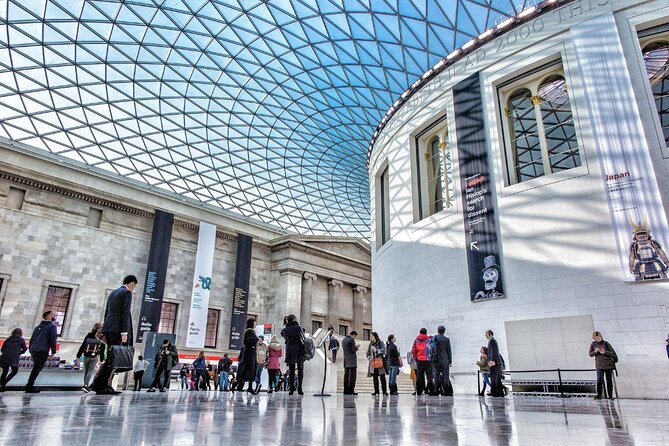
- Immerse in Bloomsbury’s literary history and iconic landmarks
- Enjoy a private two-hour walking tour with a British Museum visit
- Personalized recommendations and expert guidance enhance the experience
- Flexible booking, competitive pricing , and hassle-free cancellation policy
Here's some more nearby activities we've reviewed
- Ranthambore National Park Safari Booking
- The Kensington Palace Gardens Royal High Tea
- The Ultimate Jack the Ripper
- The Cloak and Dagger Tour in London
Tour Overview
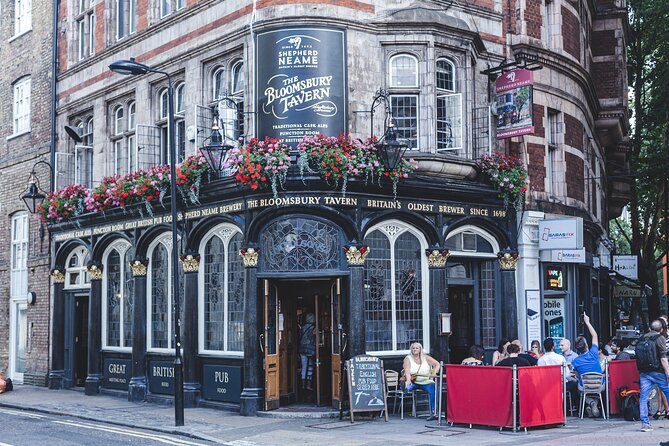
The private walking tour of Bloomsbury, London offers a captivating exploration of this historic neighborhood, providing an insightful journey through its cultural landmarks and hidden gems.
Bloomsbury is rich in historic landmarks, with each step revealing layers of local culture . Visitors can enjoy the vibrant literary history of the Bloomsbury Group, whose members included Virginia Woolf and E.M. Forster.
The tour may take you past the iconic British Museum, known for its vast collection of artifacts spanning centuries. As you stroll through the leafy squares and elegant streets, you’ll feel the essence of Bloomsbury’s unique charm.
This experience is a perfect blend of history, culture , and discovery , offering a glimpse into London’s past and present.
Duration and Inclusions
Explore the two-hour private walking tour of Bloomsbury, London, which includes an interior visit to the British Museum, personalized recommendations , meals , and gratuities , all guided by a private expert to enhance your London experience.
During the tour, you can expect:
Hidden Gems: Uncover lesser-known spots and stories that are off the beaten path.
Local Insights: Gain insider knowledge about the area from a guide who knows Bloomsbury intimately.
Culinary Delights: Enjoy a meal at a local eatery, tasting authentic flavors of London.
Gratuity Inclusions: Don’t worry about tipping; it’s all taken care of, allowing you to focus on the experience.
Enjoy the rich history and vibrant culture of Bloomsbury with this comprehensive private tour.
Personalization Options
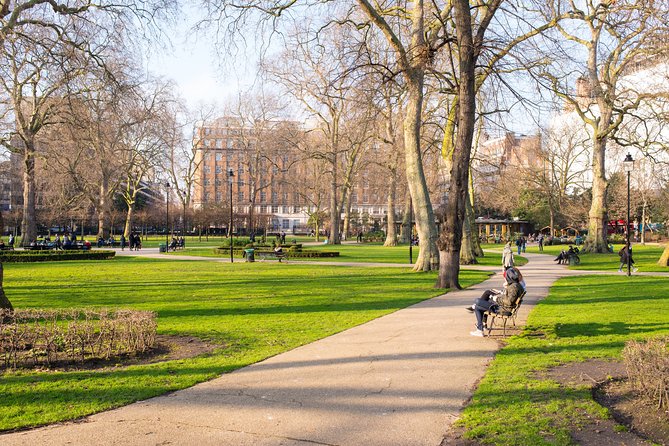
Enhance your private walking tour of Bloomsbury, London by customizing it to your preferences and interests. Enjoy customized experiences and tailored itineraries that cater specifically to what you want to see and do.
Whether you’re a literature enthusiast interested in the Bloomsbury Group, a history buff wanting to explore the area’s past, or a foodie looking to explore the culinary delights of Bloomsbury, the tour can be personalized to suit your tastes.
Your private expert guide will work with you to create a unique and personalized experience that ensures you make the most of your time in Bloomsbury. From choosing specific landmarks to focusing on particular aspects of the area, the tour can be shaped to match your desires perfectly.
Booking and Pricing Details
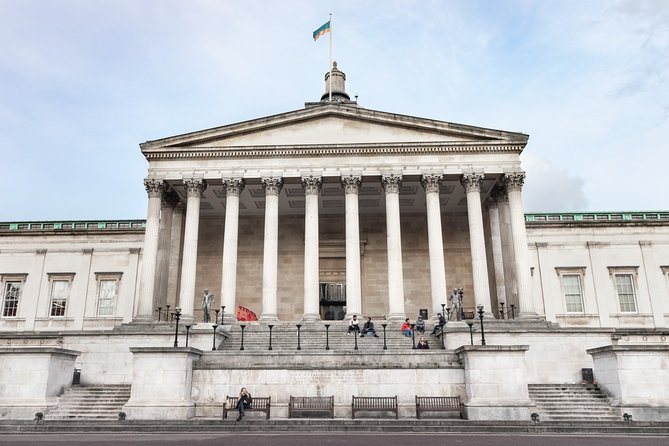
Discover the convenient booking options and transparent pricing details for the private walking tour of Bloomsbury in London. When considering this exclusive experience, visitors can benefit from the following:
Pricing Comparison : The tour offers competitive pricing starting from $131.53, ensuring affordability.
Group Discounts : Group bookings may be eligible for special discounts, making it a great option for families or friends traveling together.
Lowest Price Guarantee : Rest assured that you’re getting the best deal available for this tour.
Flexible Booking : With the option to Reserve Now and Pay Later, travelers can secure their spot without immediate payment, providing added convenience.
These features make booking the Bloomsbury walking tour a straightforward and cost-effective choice for exploring London’s cultural heart.
Cancellation Policy
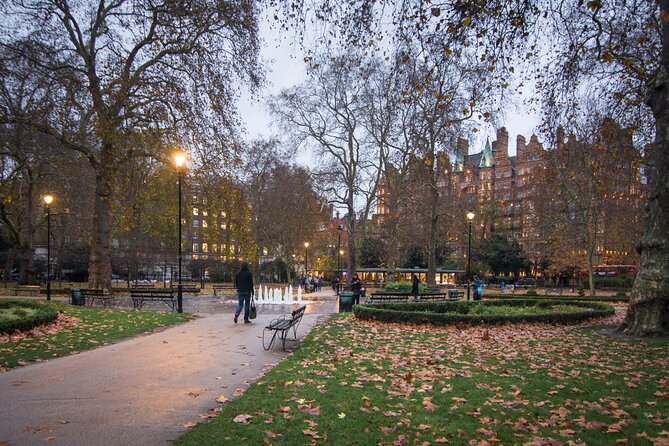
The cancellation policy for the private walking tour of Bloomsbury in London allows travelers to cancel their experience with a full refund if done up to 24 hours before the scheduled start time. If cancellations are made within 24 hours of the tour, charges will apply.
In the case of unfavorable weather conditions , the tour will still proceed as scheduled unless there are extreme circumstances that may affect the safety of the participants. In such cases, the tour operator will contact travelers to discuss possible alternatives.
The refund process for cancellations made within the allowable timeframe is straightforward, ensuring a hassle-free experience for travelers. It’s important to consider the weather considerations when planning for the tour to make the most of this exciting experience.
Meeting Point Information
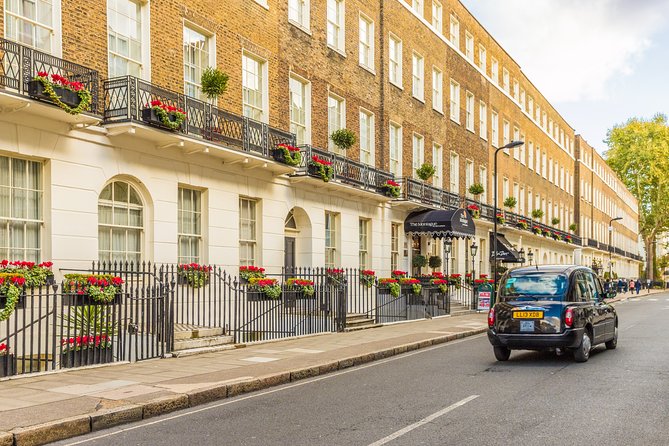
Located at Underground Ltd, Holborn Station on Kingsway in London WC2B 6AA, the meeting point for the private walking tour of Bloomsbury provides easy access for participants to begin their exploration of the area. When meeting at this location, participants can expect the following:
Convenient Transport : Holborn Station offers easy access via the London Underground, making it a hassle-free starting point.
Proximity to Bloomsbury : Situated near the heart of Bloomsbury, participants can quickly enjoy the neighborhood’s charm.
Nearby Attractions : Within walking distance, visitors can explore the British Museum and Russell Square, enhancing their tour experience.
Local Dining Options : After the tour, participants can enjoy a variety of cafes and restaurants in Bloomsbury for a delightful culinary experience.
Reviews and Ratings
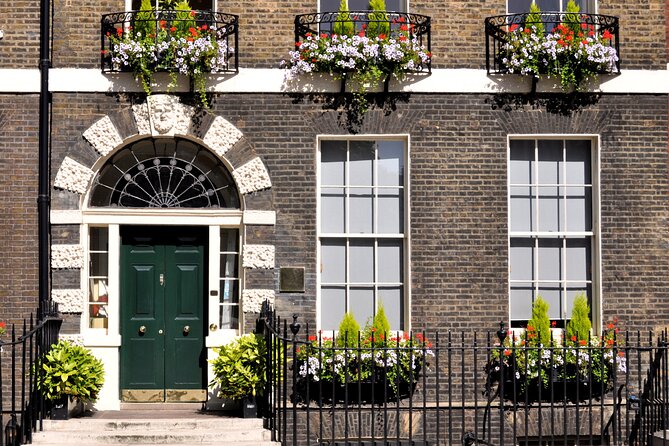
Immersing yourself in the experiences of previous participants, the reviews and ratings of the private walking tour of Bloomsbury offer valuable insights into the quality of this guided exploration. Review analysis shows an impressive overall rating of 5.0, based on feedback from 6 reviewers.
The breakdown includes a mix of 5- star , 4- star , 3-star, 2-star, and 1-star ratings , providing a comprehensive view of customer feedback . Reviews verified by Viator and Tripadvisor attest to the authenticity of the opinions shared.
Customers have praised the tour for its informative and engaging nature, as well as the personalized service provided by expert guides. This feedback highlights the tour’s success in delivering a memorable and enriching experience for visitors exploring Bloomsbury on foot.
Additional Information
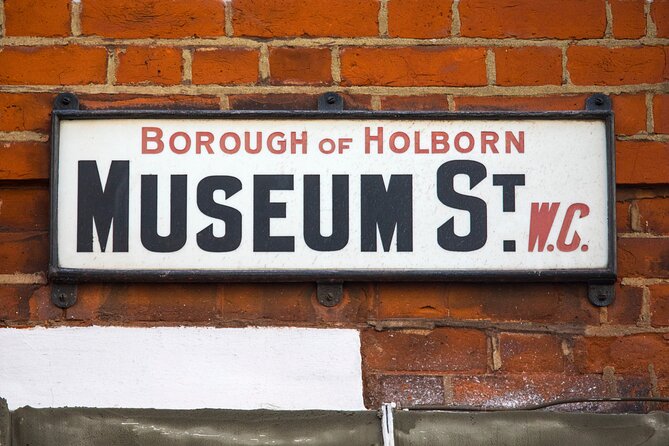
For a comprehensive understanding of the private walking tour of Bloomsbury, visitors can explore essential details under the ‘Additional Information’ section. Here are some key points to note:
Hidden Gems : The tour includes access to lesser-known spots in Bloomsbury that hold historical significance and charm.
Local Insights : Gain valuable knowledge and anecdotes about the area from a knowledgeable local guide who can provide insider perspectives.
Cancellation Policy Details : Understand the terms for canceling or rescheduling the tour if needed.
Traveler Photos : View images captured by previous tour participants to get a glimpse of the experience before booking.
Here's a few more nearby tours and experiences we have reviewed.
- London Eye River Cruise and Standard London Eye Ticket
- London by Night Sightseeing Tour – Open Top Bus
- The Beatles London Walk
- Private Sherlock Holmes Walking Tour in London
- Inner Circle Access of Stonehenge Including Bath and Lacock Day Tour From London
- White Cliffs of Dover and Canterbury Cathedral Tour From London
Common questions
Are there any restrictions on the number of participants for the private guided walking tour of bloomsbury, london.
Group size for the private guided walking tour of Bloomsbury, London is flexible. Participants can customize their experience. Language preferences can be accommodated. There are no specific restrictions on the number of participants for this personalized tour.
Can I Request a Specific Language-Speaking Guide for the Tour?
A guest can request a specific language-speaking guide for the tour. Tour customization allows visitors to tailor their experience. Language preferences are accommodated to enhance the tour’s understanding and enjoyment.
Is There a Dress Code or Recommended Attire for the Walking Tour?
When going on the walking tour, it’s advisable to dress comfortably and consider the weather conditions . Wear suitable footwear for walking. Layers work well for changing weather. There is no strict dress code, but being prepared is key.
Are There Any Age Restrictions for Participants on the Tour?
Age restrictions are not specified. Group size restrictions may apply. For a detailed understanding, visitors are encouraged to review the tour’s booking information and additional details. The tour offers personalized experiences and expert guidance.
Can Special Accommodations Be Made for Individuals With Mobility Issues or Disabilities?
Accessibility options are available to ensure inclusive experiences for individuals with mobility issues or disabilities. The tour can be personalized to accommodate specific needs. The expert guide will assist in making necessary arrangements for a comfortable and enjoyable visit.
Here's more of our most recent tour reviews happening neaby
- London Old Pub Crawl: Exclusive Self-Guided Audio Tour
- London: 2-Hour Historic Pub Tour
- Private Transfer: From Camden to London Heathrow Airport.
- London: 2-Hour Haunted Pub Walking Tour
- Private Transfer: London Heathrow Airport to Winchester.
- Heathrow Airport to Tooley Street LondonSE1P 4SA
- Wapping and the Old London Docks: a Self-Guided Audio Tour
- London: Medieval History Walking Tour From the Tower
- London: The Changing of the Guard Experience
- Blockbuster Film Tours at the Old Royal Naval College
- London: Same-Day Luggage Delivery To/From Hotel or Airport
Experience the magic of Bloomsbury with a private guided walking tour that includes a visit to the British Museum.
With personalized recommendations, enriching insights , and included meals and gratuities , this tour offers a unique and unforgettable way to explore one of London’s most charming neighborhoods.
Book now for a bespoke adventure filled with history, culture, and hidden gems waiting to be discovered.

IMAGES
VIDEO
COMMENTS
Bloomsbury Walk. From Russell Square to the British Museum, Bedford Square to Lamb's Conduit Street, Bloomsbury is one of the most famous central London neighborhoods. Set in a beautiful part of the UK capital, my Bloomsbury walk is the perfect way to get into London's literary past, explore pretty streets, eat and drink at independent cafes and restaurants, and indulge your inner culture ...
This 3-hour walking tour by London Literary Tours explores the lives of Bloomsbury's former writer residents. Explore how writers like Yeats, Tagore, Eliot, Pound and members of the Bloomsbury Set responded and contributed to world events and social change. ... worked and died in the neighbourhood on this Women of Bloomsbury walking tour. For 2 ...
Wander the quiet, atmospheric streets of Bloomsbury and take in unusual sculptures, sneaky plaques and unexpected details that help you unravel the area's unique charm. The meeting point is outside Holborn Station, the corner of High Holborn and Southampton Row. The address is 120 High Holborn, London WC1V 6RD and its the corner diagonally ...
Private Guided Walking Tour of Bloomsbury, London. 6. Historical Tours. 2 hours. Bloomsbury sits in the heart of London, and has always attracted the great thinkers, writers, artists, and scientists of… Free cancellation. Not sure? You can cancel this booking up to 24 hours in advance for a full refund. from. £103.
Welcome to our Bloomsbury and Fitzrovia Tour, one of a series of walks that aims to take you on a journey through central London to discover some of the most pioneering and inspirational women in British history. Each stop is illustrated with portraits from the National Portrait Gallery collection. All you need is your phone or mobile device ...
Bloomsbury is considered by many to be the literary heart of London. Previously home to literary greats such as Charles Dickens and Virginia Wolf, the district is replete with rich history, the best of which is revealed on this 2-hour walking tour of Bloomsbury. Ideal for literature enthusiasts, this tour takes you to charming English squares and buildings inhabited by iconic authors. Enjoy an ...
Bloomsbury is considered by many to be the literary heart of London. Previously home to literary greats such as Charles Dickens and Virginia Wolf, the district is replete with rich history, the best of which is revealed on this 2-hour walking tour of Bloomsbury. Ideal for literature enthusiasts, this tour takes you to charming English squares and buildings inhabited by iconic authors. Enjoy an ...
Exploring London's Bloomsbury district—a haven for influential writers in the 19th and 20th centuries—independently might leave you only skating over its literary credentials. With this private walk, tour the squares and museums with a guide for a more comprehensive look at the area than if exploring alone. Visit the homes of writers such as Charles Dickens, chart the life of Virginia ...
Full description. This private walking tour takes you on an interesting 2.5 hour walk around the Bloomsbury district of London. What Montmartre in Paris is to the world of art then so is Bloomsbury to the world of literature. Bloomsbury was the center of the English-speaking literary world in the 19th and 20th centuries and to a degree still is.
Get your tickets for Private Guided Walking Tour of Bloomsbury, London! Highlights. 🎨 Walk in the footsteps of great thinkers and artists in the historic Bloomsbury. 🏛️ Marvel at the iconic British Museum and its rich history—exterior views included. 🌳 Discover hidden stories in serene gardens and squares, revealing a fascinating past.
Bloomsbury Walking Tour. Discover this 6.8-km out-and-back trail near Camden, London. Generally considered an easy route, it takes an average of 1 h 34 min to complete. This is a very popular area for walking, so you'll likely encounter other people while exploring.
Explore London's top 20 world famous landmarks on a 3 hour walking tour then visit Westminster Abbey One of the United …. 13. Canterbury Cathedral, Dover Castle & White Cliffs Guided Day Tour from London. Get out of London to explore England's southeast with this full-day tour of Canterbury and Dover.
Bloomsbury and British Museum Walking Tour. Experience this 1.8-mile point-to-point trail near Camden, London. Generally considered an easy route, it takes an average of 41 min to complete. This trail is great for walking, and it's unlikely you'll encounter many other people while exploring. This walking tour shows you one of the intellectual ...
Book the most popular Walking tours in Bloomsbury, London. Best price and money back guarantee! Read the reviews of your fellow travelers.
Grant Museum of Zoolology. Soon our walking tour from Holborn to Bloomsbury will conclude. Walk to the end of the road to the junction with Gower Street, turn right and walk up. There is another museum on the left hand side of the junction with University Street which is also worthy of note and also free. There, the Grant museum of Zoology can ...
London Literary Private Walking Tour Of Bloomsbury. 4. Historical Tours. from . $214.83. per adult (price varies by group size) Women of Bloomsbury Walking Tour. 17. Historical Tours. from . $40.28. ... Private Guided Walking Tour of Bloomsbury, London provided by Bespoke Britain. London.
A Walking Tour of Bloomsbury's Architectural Landmarks. Bloomsbury, a once aristocratic enclave and London's first suburb, is a network of quiet squares and grand Georgian terraces. The area has long attracted artists, authors and lawyers who weaved the area's ambience into their work.
11. VIP Tower of London and Crown Jewels Tour with Private Beefeater Meet & Greet. 62. Historical Tours. 3 hours. This is a full 3-hour guided tour of the highlights of the must-see Tower of London including a private Beefeater encounter…. Free cancellation. Recommended by 90% of travellers. 12.
Half-day Tours in London: Check out 31 reviews and photos of Viator's London Literary Private Walking Tour Of Bloomsbury
Bloomsbury and British Museum Walking Tour. Experience this 2.9-km point-to-point trail near Camden, London. Generally considered an easy route, it takes an average of 41 min to complete. This trail is great for walking, and it's unlikely you'll encounter many other people while exploring. This walking tour shows you one of the intellectual ...
Wander through the Bloomsbury area of London, made famous by Virginia Woolf and Charles Dickens, on this writers walk and see tourist attractions such as the British Museum, the Lamb pub, Great Ormond Street Hospital and other places associated with famous British writers. Allow 2 hours. Best time to do it is any time during daylight hours ...
Follow the literary footsteps of icons in Bloomsbury, London, where hidden mysteries and untold stories await around every corner.